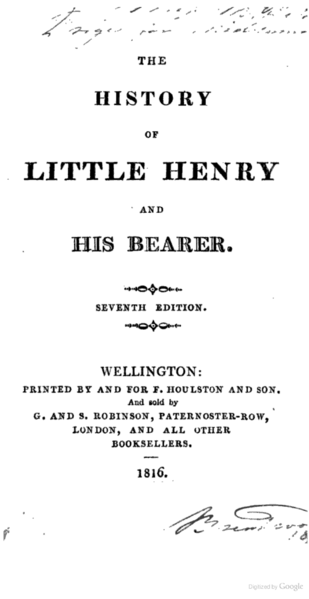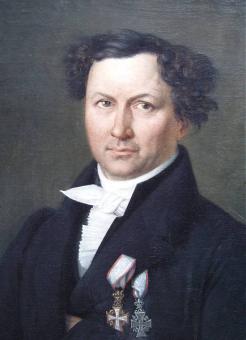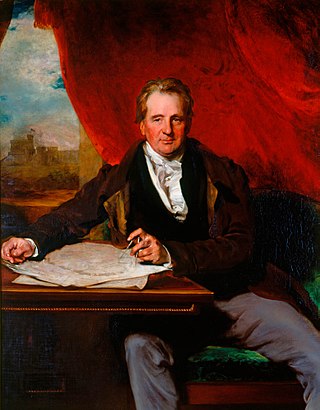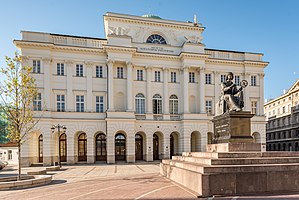
Stanisław Wawrzyniec Staszic was a leading figure in the Polish Enlightenment: a Catholic priest, philosopher, geologist, writer, poet, translator and statesman. A physiocrat, monist, pan-Slavist and laissez-fairist, he supported many reforms in Poland. He is particularly remembered for his political writings during the "Great (Four-Year) Sejm" (1788–92) and for his large support towards the Constitution of 3 May 1791, adopted by that Sejm.

Józef Antoni Franciszek Elsner was a Polish composer, music teacher, and music theoretician, active mainly in Warsaw. He was one of the first composers in Poland to weave elements of folk music into his works.
The Düsseldorf School of painting is a term referring to a group of painters who taught or studied at the Düsseldorf Academy roughly between 1819 and 1918, first directed by the painter Wilhelm von Schadow.

Neoclassical architecture, sometimes referred to as Classical Revival architecture, is an architectural style produced by the Neoclassical movement that began in the mid-18th century in Italy, France and Germany. It became one of the most prominent architectural styles in the Western world. The prevailing styles of architecture in most of Europe for the previous two centuries, Renaissance architecture and Baroque architecture, already represented partial revivals of the Classical architecture of ancient Rome and ancient Greek architecture, but the Neoclassical movement aimed to strip away the excesses of Late Baroque and return to a purer, more complete, and more authentic classical style, adapted to modern purposes.
The ideas of the Age of Enlightenment in Poland were developed later than in Western Europe, as the Polish bourgeoisie was weaker, and szlachta (nobility) culture (Sarmatism) together with the Polish–Lithuanian Commonwealth political system were in deep crisis. The period of Polish Enlightenment began in the 1730s–40s, peaked in the reign of Poland's king, Stanisław August Poniatowski, went into decline with the Third Partition of Poland (1795) – a national tragedy inspiring a short period of sentimental writing – and ended in 1822, replaced by Romanticism.

Neoclassical architecture in Poland was centered on Warsaw under the reign of Stanisław August Poniatowski, while the modern concept of a single capital city was to some extent inapplicable in the decentralized Polish–Lithuanian Commonwealth. Classicism came to Poland in the 18th century as the result of French infiltrations into the Polish millieu. The best-known architects and artists who worked in Poland were Dominik Merlini, Jan Chrystian Kamsetzer, Szymon Bogumił Zug, Stanisław Zawadzki, Efraim Szreger, Antonio Corazzi, Jakub Kubicki, Hilary Szpilowski, Christian Piotr Aigner, Wawrzyniec Gucewicz, Bonifacy Witkowski and Danish Bertel Thorvaldsen.

Karol Podczaszyński was a Polish-Lithuanian leading Vilnius architect, a representative of the neoclassical architecture and a professor of the Vilnius University, as well as one of the pioneers of industrial design.

Staszic Palace is an edifice at ulica Nowy Świat 72, Warsaw, Poland. It is the seat of the Polish Academy of Sciences.

Mostowski Palace is an 18th-century palace in Warsaw, Poland, located at ul. Nowolipie 2 — prior to World War II, at ul. Przejazd 15.

The following is a list of the published works of Mary Martha Sherwood. Because it relies on M. Nancy Cutt's annotated bibliography of Sherwood's books in Mrs. Sherwood and her Books for Children, this list does not include her many periodical articles, such as those she wrote for The Youth's Magazine. The list follows Cutt's generic divisions.

The architecture of Poland includes modern and historical monuments of architectural and historical importance.

Jørgen Hansen Koch was a Neoclassical Danish architect. He was chief of the national Danish building administration from 1835 and director of the Royal Danish Academy of Fine Arts from 1844 to 1849.

Sir Jeffry Wyatville was an English architect and garden designer. Born Jeffry Wyatt into an established dynasty of architects, in 1824 he was allowed by King George IV to change his surname to Wyatville. He is mainly remembered for making alterations and extensions to Chatsworth House and Windsor Castle.

The Palace of the Ministry of Revenues and Treasury is located at 3/5 Bank Square in Warsaw. It is sometimes simply referred to as the Commission Palace. Currently it is not the home to the named ministry, but serves as Warsaw's official city hall, the seat of the President of Warsaw and the provincial office of the Mazovia province.
Louis Charles Achille d'Artois de Bournonville was a French writer, librettist and dramatist.
Armand d'Artois was a 19th-century French playwright and librettist, and also Achille d'Artois's brother.
The French Restoration style was predominantly Neoclassicism, though it also showed the beginnings of Romanticism in music and literature. The term describes the arts, architecture, and decorative arts of the Bourbon Restoration period (1814–1830), during the reign of Louis XVIII and Charles X from the fall of Napoleon to the July Revolution of 1830 and the beginning of the reign of Louis-Philippe.

Marek Marceli Józef Jan Chrzciciel Tarczewski was a Polish lawyer, official and attorney who defended Polish conspirators, as well as publisher and freemason.















